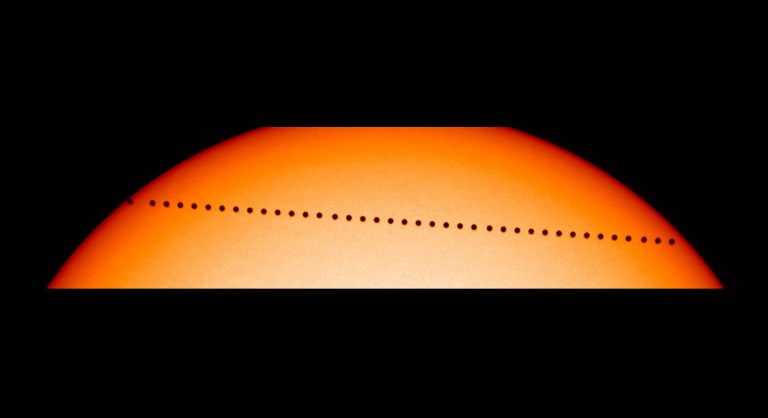
PARIS, France (AFP) Monday 5/9/2016 by Pascale MOLLARD Mariëtte Le Roux– Astronomers on Monday were preparing for one of the highlights of the skywatchers’ year, when the Sun, Mercury and Earth all line up — a phenomenon that happens just a dozen or so times per century.
Mercury will be seen through telescopes as a black dot inching over the face of our star, providing a celestial spectacle — weather permitting — that will last seven and a half hours.
“At the start, Mercury will look as if it is nibbling at the edge of the Sun, and then it will very slowly cross its surface and leave the other side,” said Pascal Descamps of the Paris Observatory.
“It’s something rare, because it requires the Sun, Mercury and Earth to be in almost perfect alignment.”
The smallest recognised planet in the Solar System, Mercury completes an orbit every 88 days, and passes between the Earth and the Sun every 116 days.
But its orbit is tilted in relation to Earth’s, which means it usually appears — from our perspective — to pass above or below the Sun.
Thirteen times each century, however, the two orbits align such that even amateur astronomers can see the tiny planet tens of millions of kilometres (miles) away.
According to Britain’s Royal Astronomical Society (RAS), most of Western Europe, the western parts of North and West Africa, eastern North America, and most of South America will be able to view the entire transit, which will last from 1112 GMT to 1842 GMT.
The rest of north and south America, the eastern Pacific, the remainder of Africa and most of Asia, will see parts of the event.
Observers in east and southeast Asia and Australasia, however, will miss out entirely.
Weird planet
The closest planet to the Sun and a third the size of Earth, Mercury is one of the Solar System’s curiosities.
It is one of the four rocky planets of the inner Solar System but has no atmosphere and its metallic body is scarred by collisions from space rocks.
Daytime on Mercury is six times hotter than the hottest place on Earth, and nighttime can be more than twice as cold as the coldest place on our planet.
It rotates so slowly — three times for every two orbits — that, bizarrely, Mercury’s day is twice as long as its year.
The transit of Mercury was first recorded by French astronomer Pierre Gassendi. He observed it through a telescope in 1631, two decades after the instrument was invented.
German astronomer Johannes Kepler had correctly predicted that transit, but died in 1630 before he could witness the event.
The last Mercury lineup was 10 years ago, and the next will be in 2019, followed by 2032 and 2049.
“It is always exciting to see rare astronomical phenomena such as this transit of Mercury,” said RAS President Martin Barstow. “They show that astronomy is a science that is accessible to everyone.”
But be warned: looking directly at the phenomenon can result in permanent eye damage, as only a very small part of the Sun will be blocked out.
One option is to use a telescope or binoculars to project the image onto a white surface. Stargazers can also observe the event through a telescope with a strong filter or — most safely of all — on the Internet.
© 1994-2016 Agence France-Presse








